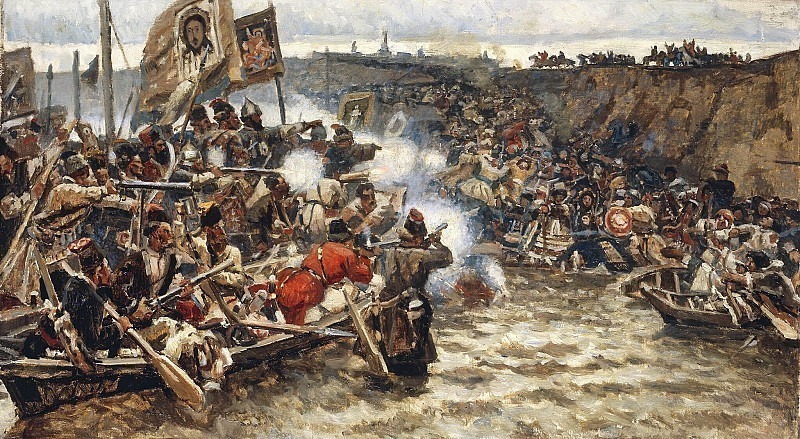The conquest of Siberia by Ermak Vasily Ivanovich Surikov (1848-1916)
Vasily Ivanovich Surikov – The conquest of Siberia by Ermak
Edit attribution
Download full size: 2048×1123 px (0,5 Mb)
Painter: Vasily Ivanovich Surikov
Location: The State Tretyakov Gallery, Moscow (Государственная Третьяковская галерея).
The author did not find it easy to paint this picture, and it took him four years to complete it. He finished it only in 1895. It was not by accident that he decided to paint this particular picture, because it was very important for Russia’s liberation from the Tatar khan. In addition, the author himself was born in Siberia, so he had deep feelings for his homeland. The canvas depicts the battle between the brave Yermak’s detachment and the Kuchumans.
Description of Vasily Surikov’s painting The Conquest of Siberia by Ermak
The author did not find it easy to paint this picture, and it took him four years to complete it. He finished it only in 1895. It was not by accident that he decided to paint this particular picture, because it was very important for Russia’s liberation from the Tatar khan. In addition, the author himself was born in Siberia, so he had deep feelings for his homeland.
The canvas depicts the battle between the brave Yermak’s detachment and the Kuchumans. It is clearly seen that the Russians take the "top". The hero himself is not highlighted by the artist in any way, as if to say that the commander was not very much distinguished himself from his warriors’ units. The only thing that gave us the ataman is his hand, or rather a gesture that firmly and decisively directs his troops to battle and to attack.
The faces of the Cossacks, on the contrary, express a storm of different emotions - an indestructible will and desire for victory and freedom. It does not matter that the battle is only in full swing, but it is already clearly visible how and how the battle will end. Defeated, the hordes of Tatars are fleeing the battlefield in panic.
It is not without ulterior motives that a bleak landscape has been chosen for the battle - the autumn sky is gray, the swift waters of the river are also not transparent, and the river bank is slippery and clayey. Looking at this overcast image of a real battle, you involuntarily become a participant, an observer, a fan...
Only the shining barrels of guns remain distinct and the flashes of shots soar over the battlefield as pink clouds. A special place is set for the blood stain. The scarlet stain goes to the Cossack as a sign of devotion and self-sacrifice in the name of the Motherland and honor.
Even a casual viewer, not sophisticated in art, will find in this painting a lot of feelings and experiences, will better accept, understand and perceive Russian culture, think about what our ancestors fought for and what goals they achieved.
The painting "breathes" war, an all-consuming battle in which there are neither winners nor losers. But all the same, it becomes clear that the bloodshed could not be avoided. That is why it is the war that washes away the blood and waters the tears as the savior for the people.
This picture is one of the great monuments of Russian history, which has preserved the memories of people who will never tell us about this event.
Кому понравилось
Пожалуйста, подождите
На эту операцию может потребоваться несколько секунд.
Информация появится в новом окне,
если открытие новых окон не запрещено в настройках вашего браузера.
You need to login
Для работы с коллекциями – пожалуйста, войдите в аккаунт (open in new window).















You cannot comment Why?
The painting depicts a chaotic and intense battle scene, likely the conquest of Siberia by the Cossack leader Yermak Timofeyevich. The foreground is dominated by several boats filled with men engaged in combat. They are armed with muskets, some of which are firing, as evidenced by the puffs of smoke and muzzle flashes. Men are rowing, fighting, and falling into the water. Biblical banners, displaying the faces of saints, are prominently held aloft, suggesting a religious motivation or justification for the campaign.
In the mid-ground, a large throng of combatants is visible on a steep embankment. Soldiers on horseback are seen on the crest of the hill. The scene is filled with action and violence, with figures engaged in hand-to-hand combat and firing weapons. The overall atmosphere is one of struggle and the harsh realities of warfare.
The subtexts of the painting include: